This newsletter for the week of May 5 heads to Switzerland, specifically the canton of Glarus, southeast of Zurich (no, not New Glarus, Wisconsin!), where we find an abundance of the last surviving textile drying towers (Tröckneturm and Hänggiturm) that are a subject of an award-winning book by artist Stéphanie Baechler. Forget Me Not (Vergissmeinnicht) spurred me to grab an old G. E. Kidder Smith book off my shelf and include it in the bottom of the newsletter; in between are the usual headlines and new releases. Happy reading!
***Note: I’m taking off next week, so the next issue of this newsletter will land in your inbox on Week 21/2025, or May 19.***
Book of the Week:
Forget Me Not (Vergissmeinnicht), by Stéphanie Baechler, with photographs by Ladina Bischof (Buy from Building Fictions / from Idea Books)
Although I wrapped up my blog in early 2024, shifting my extracurricular book interests to Substack, there are still a few pages I maintain there, among them a list of NYC bookstores, a list of my books and articles published elsewhere, and a now old-fashioned blogroll. The last has links found in a few categories: websites, booksellers, and book awards. It’s probably no surprise to anyone who reads this newsletter that a list of awards pertaining to architecture books is short: a handful from the Society of Architectural Historians, a couple from the Society of Architectural Historians of Great Britain, the DAM Architectural Book Award, WAF’s Architecture Book of the Year Award, and a few others. Nevertheless, occasionally an architecture book—or one tangentially related to architecture, as in the case of Forget Me Not (Vergissmeinnicht) by Stéphanie Baechler—wins a book prize that pulls from a wider range of subjects, not just architecture. Instances like this give me pause.
The award garnered this year by Baechler’s art book about textile drying towers (Tröckneturm) in eastern Switzerland is a big one: the Goldene Letter, the highest award in the annual “Best Book Design from all over the World” competition organized by Stiftung Buchkunst (German Foundation for Book Design), which also holds “The Best German Book Design” competition and a “Sponsorship Prize for Young Book Design.” Featuring a design by Rudy Guedj, Forget Me Not (Vergissmeinnicht) bested an astounding 550 publications from 32 countries—each of which had already won a national prize (Forget Me Not, published by Amsterdam’s Building Fictions, won a Dutch award in 2024) or was recommended by a body of experts. With its focus on book design, art and architecture books are certainly contenders, but so are books of poetry, design, and science, to cite the genres of the one gold and two silver medalists.
Forget Me Not (Vergissmeinnicht) is a documentation of Baechler’s 2024 art installation that consisted of 370 meters of fabric suspended from the 25-meter-tall, nearly 200-year-old Tröckneturm in St. Gallen, but the book is also an integral part of the artwork. The book marries Baechler’s first-person, highly autobiographical narrative on researching and realizing the installation, photographer Ladina Bischof’s photos of the 27 remaining drying towers in Switzerland, and essays by Andreas Zangger and Michael Gnehm. Taking up most of the book’s 404 pages are Baechler’s text and related images in red and Bischof’s monochrome photos, the first laid upon the latter by Guedj. It’s a curious but ultimately successful design that turns each spread into a unique canvas, and in many cases finds the archival images in red bleeding from one page or spread to the next. The examples illustrated here show how the red images often respect the black-and-white photos of the drying towers, but sometimes they act like veils, akin to the actual textiles that once hung from the bulky eaves of the towers.
While the Goldene Letter-winning book design garners attention, it is far from the only redeeming aspect of the book. The design works with Baechler’s text and images to create a quick and captivating narrative. There are many parts to the artist’s story, which began with an archival photo of a drying tower, the Glarus Hänggiturm, that she discovered in 2020, during a residency at TaDA—Textile and Design Alliance (red image in above spread). We read about and see Baechler’s discoveries in various archives, her attempts to define the installation and obtain funding for it, her many tangential findings related to textiles, and the resolution of the many details for the textiles in the final installation, from fireproofing the fabric to building custom rollers (with her father) for retracting the strands of fabric in inclement weather. There are also paragraphs about self-doubt during difficult parts of the project, getting help from friends, and even the birth of her first child, which, among other circumstances, delayed the project so the installation and book were completed in 2024 rather than 2023. It is a bit like a scrapbook or diary, where personal anecdotes sit alongside historical artifacts and photographs of the buildings.
Baechler’s focus on a distinctive type of vernacular architecture hardly means the project is just about architecture. As with any building pertaining to craft and industry, the installation and book are about technological change over time, how local crafts relate to global markets, and other things beyond the form of the drying towers. Much of these wider contexts are spelled out by Zangger and Gnehm in their essays at the back of the book, though as much can be gleaned from reading Baechler’s narrative. By the time a reader reaches these two essays, they might be wondering, “How did the final installation turn out?” Though not depicted in the pages of the book, full-color photos on glossy sheets are tucked into a flap at the back cover—an unexpected surprise that brings closure to the four-year process documented in the book and further illuminates the beauty of the historic wooden Tröckneturm.
Books Released This Week (and Next Week):
(In the United States, a curated list)
Frei Otto: Building with Nature, edited by Joaquín Medina Warmburg and Anna Maria Meister (Buy from Prestel / from Amazon / from Bookshop) — “Drawing on the latest research and exclusive access to archival materials, this visually stunning monograph traces Otto’s groundbreaking career as one of the twentieth century’s most important and influential architects.”
Housing in the Metropolitan Area of Barcelona: IMPSOL 2015-2024, edited by Marta Poch (Buy from Actar Publishers / from Amazon / from Bookshop) — “This publication brings together the projects and works developed by the Metropolitan Institute of Land Development and Property Management (IMPSOL) between 2015 and 2024 that represent the new criteria: architectural quality, energy efficiency, typological innovation and inclusivity.”
Ukrainian Modernism: Modernist Architecture of Ukraine, by Dmytro Soloviov (Buy from FUEL / from Amazon / from Bookshop) — “The most comprehensive publication to date on the stunning modernist architecture that defined the landscape of Soviet-era Ukraine.”
Architecture Connecting: Living Structures, edited by Louisiana Museum of Modern Art, Mette Marie Kallehauge and Lærke Rydal Jørgensen (Buy from Lars Müller Publishers / from Amazon / from Bookshop) — “Marking the first in a new series of exhibitions, this project from the Louisiana Museum of Modern Art highlights three design studios with biochemistry and biology at the core of their practice.”
Bio/Matter/Techno/Synthetics: Design Futures for the More than Human, edited by Franca Trubiano, et. al. (Buy from Actar Publishers / from Amazon / from Bookshop) — “The twenty-three papers and five editorials collected in this volume […] are grounded in the production and representation of emergent ecologies, non-human agency, machine learning, and responsive computation.”
Dispositional Intelligence in Architecture, by José Aragüez (Buy from Actar Publishers / from Amazon / from Bookshop) — “Three highly important yet radically overlooked bodies of work are examined”: Italian architect and artist Vittorio Giorgini, Israeli architect and geometer Michaël Burt, and engineer and theorist Cecil Balmond.
Extraordinary Pools, by Naina Gupta (Buy from PA Press / from Amazon / from Bookshop) — “Extraordinary Pools is a mosaic of exceptional public and private examples of pools, reasserting the protean quality of the swimming pool as a space of activity, pleasure, and excess.”
London Contemporary Architecture Map, by Oliver Wainwright (Buy from Blue Crow Media / from Amazon / from Bookshop) — “The map features 50 projects, from museums and major redevelopments to social housing and urban gardens, alongside an introduction, building details and original photography.”
The Manifesto House: Buildings that Changed the Future of Architecture, by Owen Hopkins (Buy from Yale University Press / from Amazon / from Bookshop) — “Manifesto houses reflect new visions for how we can live. Often extreme and uncompromising, they are vehicles for innovation, new ideas, and new ways of doing things.”
Full disclosure: As an Amazon Associate, AbeBooks Affiliate, and Bookshop.org Affiliate, I earn commissions from qualifying purchases made via any relevant links above and below.
Book News:
Over at World-Architects, I highlighted two recent books by Liliane Wong, both published by Birkhäuser: the revised and expanded edition of Adaptive Reuse: Extending the Lives of Buildings and Adaptive Reuse in Architecture: A Typological Index.
Over at the Guardian, Pratinav Anil reviews Owen Hatherley's The Alienation Effect: How Central European Émigrés Transformed the British Twentieth Century.
Over at Landscape Architecture Magazine, Zach Mortice reviews Silt Sand Slurry: Dredging, Sediment, and the Worlds We Are Making by Rob Holmes, Brett Milligan, and Gena Wirth.
For National Library Week in early April (I missed it, too), Columbia University Libraries had a short Q&A with Katherine Prater, Digital Project & Outreach Librarian at Avery Library, Columbia’s library for art and architecture collections.
From the Archives:
Although Tröckneturm (drying towers) are nowhere to be found in Switzerland Builds: Its Modern Architecture and Native Prototypes, G. E. Kidder Smith’s book has plenty of information on “native” Swiss architecture. Published in 1950, it was the first of three “Builds” books written, photographed, and laid out* by Kidder Smith, with titles on Sweden and Italy following soon after. Each one balances contemporary architecture with historical buildings to portray the countries fuller than a strict focus on the new would have afforded. Of Switzerland Build’s 234 pages, 60 are devoted to native/vernacular architecture, presented regionally rather than typologically, as the modern buildings that follows are structured.
In terms of the books making, Angelo Maggi's excellent G. E. Kidder Smith Builds: The Travel of Architectural Photography is particularly illuminating. Maggi explains how Kidder Smith traveled with his wife to document the country’s architecture, something they did with basically every one of his books. Unlike now, when travel plans are done via Google searches and maybe a trip to the library, Kidder Smith needed the assistance of someone in Switzerland. One of his New York connections, Elizabeth Bauer Mock, put him in touch with architect Alfred Roth, who was also the author of The New Architecture, a survey from 1940 that similar in many ways to Kidder Smith’s later “Build” books. Roth must have been of great assistance, given the solid selection of modern architecture in the book, though it’s hard to say how much Roth influenced Kidder Smith’s take on the country’s “native” architecture.
While no drying towers are in its pages, the vernacular buildings that are in Kidder Smith’s regional survey are a varied lot, from log houses and grain storehouses in Valais (above spread) to half-timbered houses near Zurich and stone buildings in Ticino. Just as Forget Me Not (Vergissmeinnicht) gains a visual unity through the architectural photographs of Ladina Bischof, Kidder Smith’s capable eye gives Switzerland Builds a remarkable consistency. Unfortunately, the publishers only paid for four color plates, just one of which is found in the “native architecture” section. On the last two pages of this section (below spread), Kidder Smith links timber, stone, and other materials in vernacular architecture to same materials in modern architecture, linking the other disparate expressions and technologies across time.
*Minus the cover and dust jacket, which were designed by Paul Rand.
Thank you for subscribing to A Weekly Dose of Architecture Books. If you have any comments or questions, or if you have your own book that you want to see in this newsletter, please respond to this email, or comment below if you’re reading this online. All content is freely available, but paid subscriptions that enable this newsletter to continue are welcome — thank you!
— John Hill

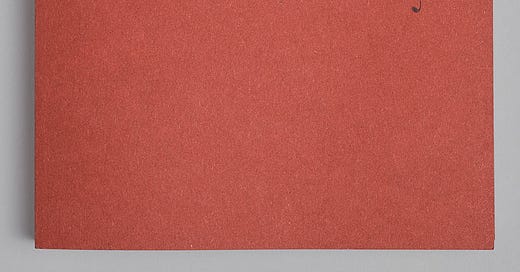



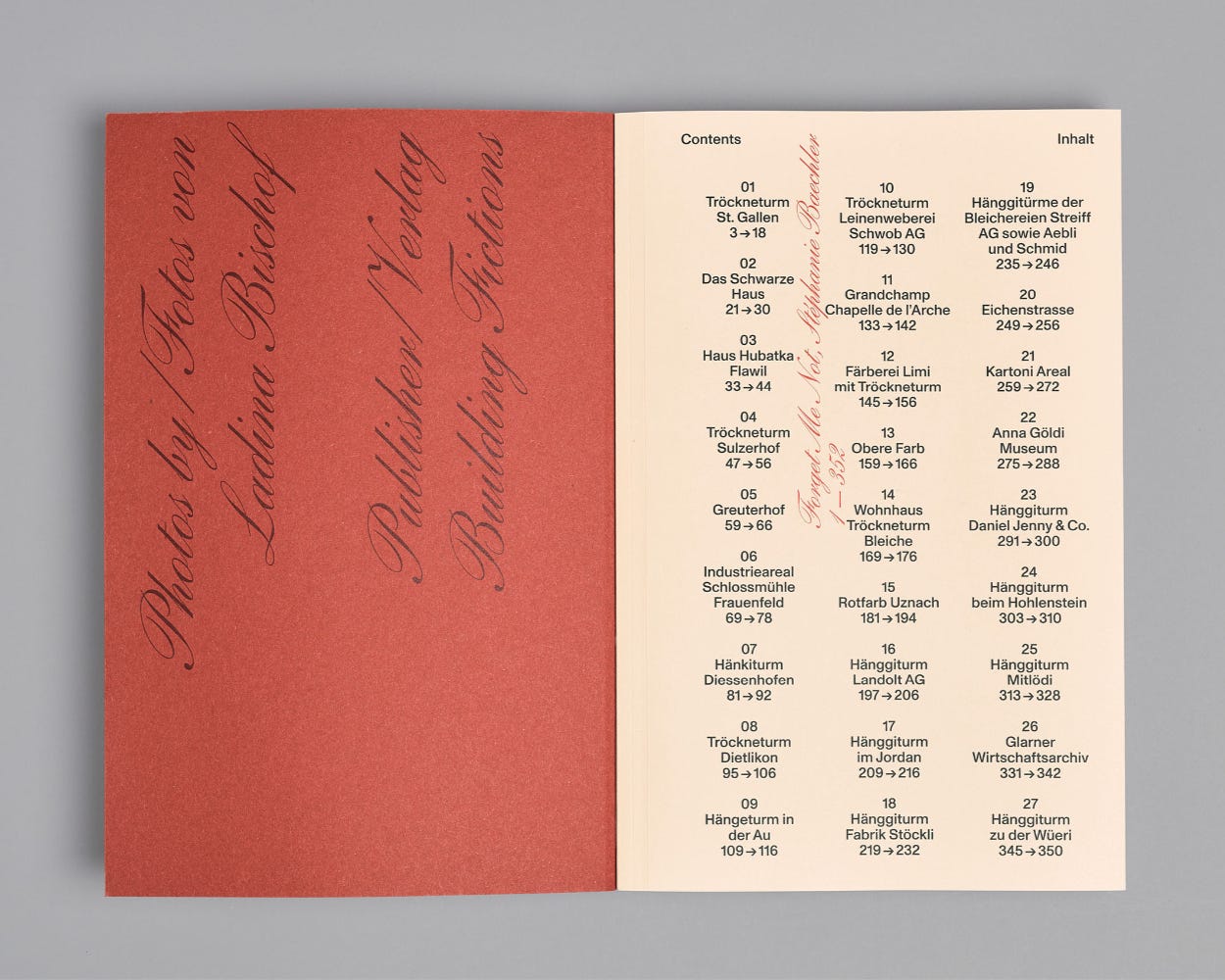
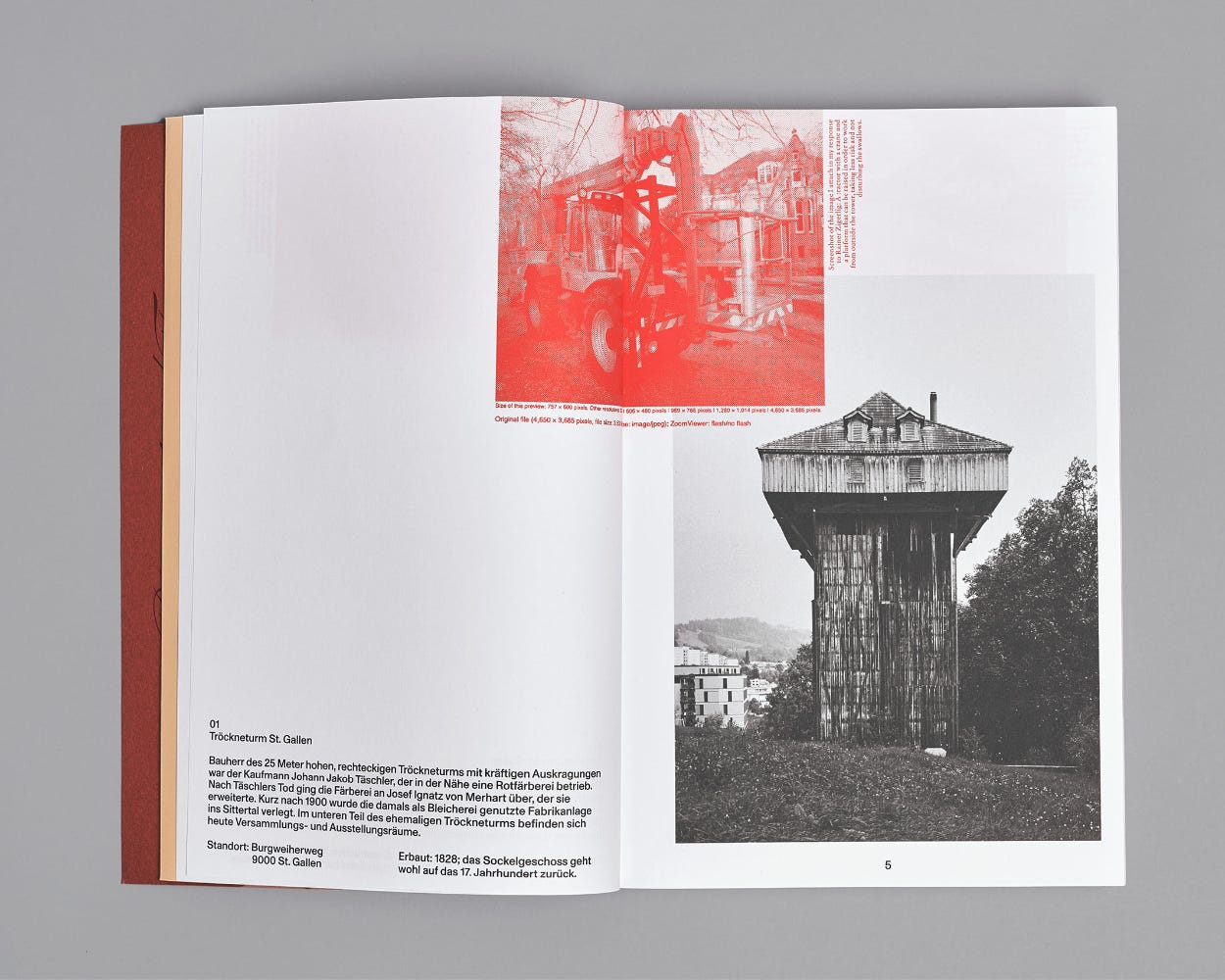
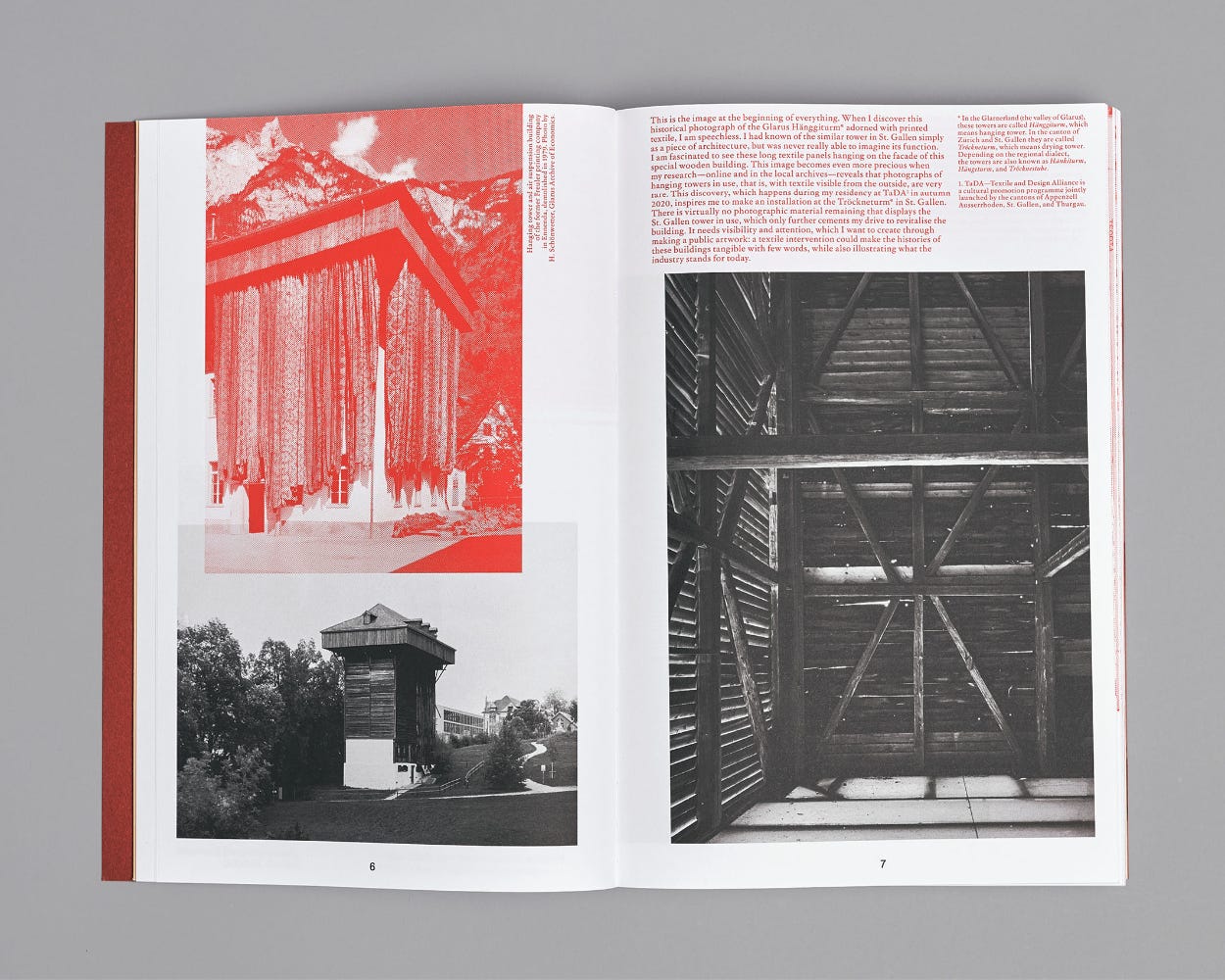
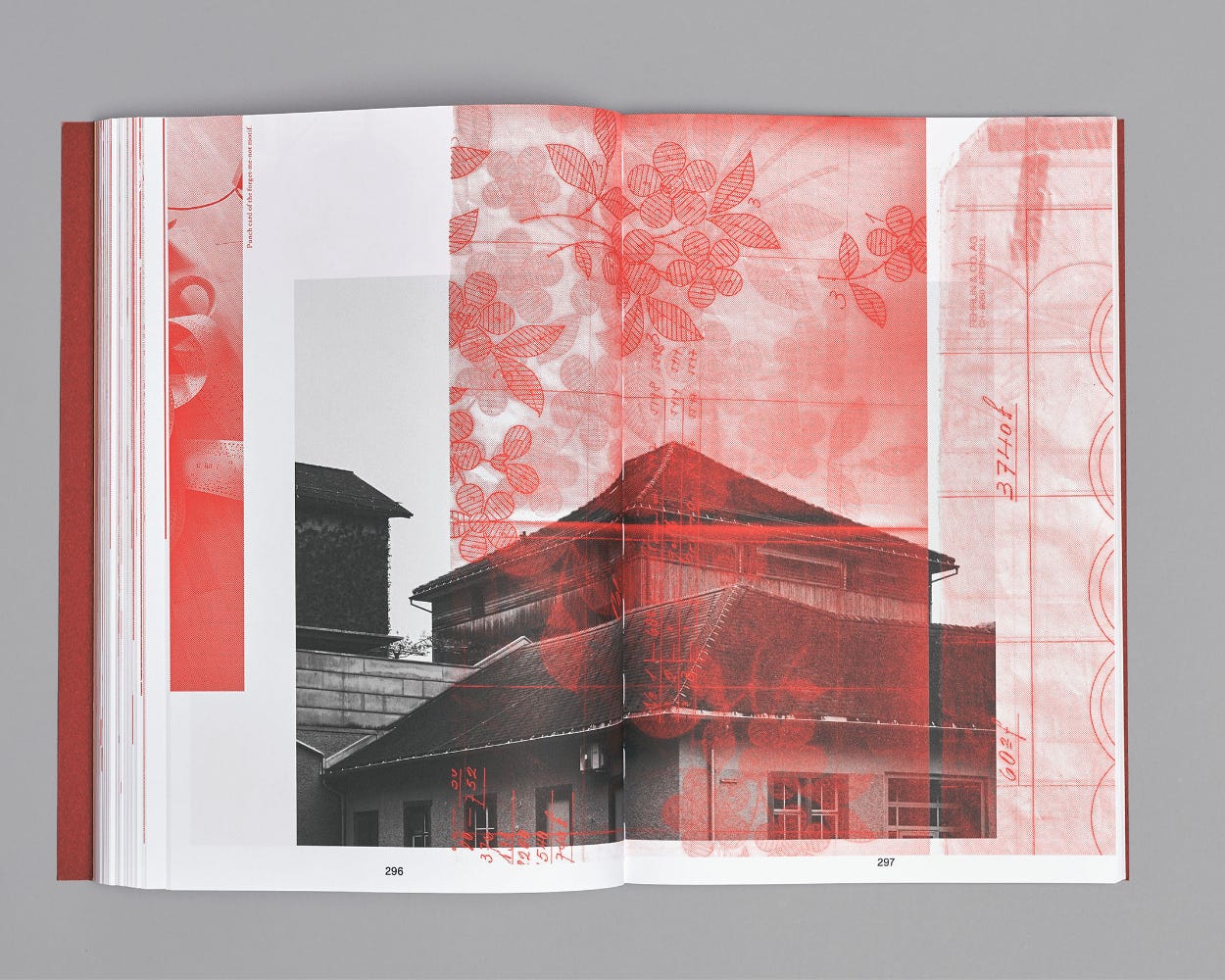



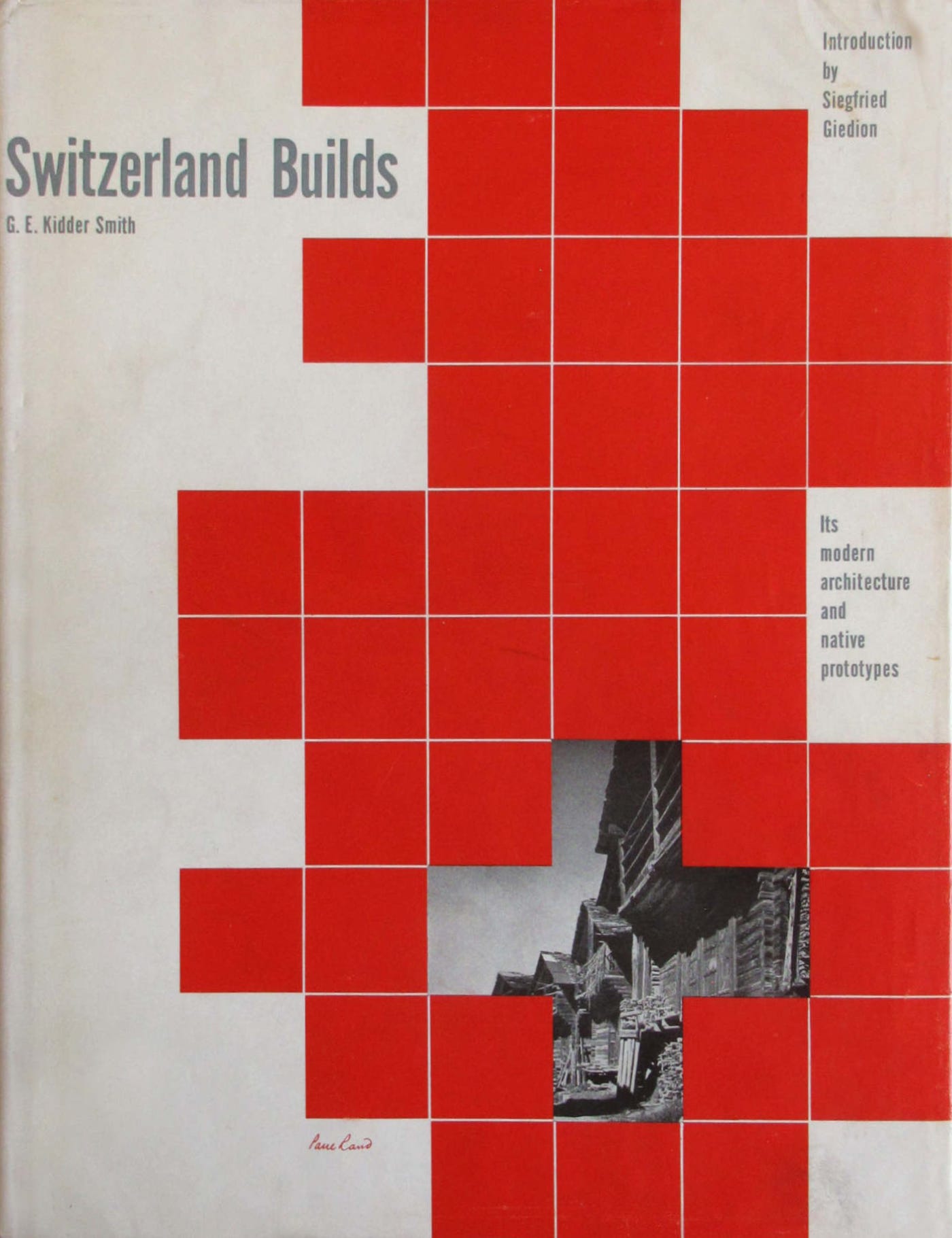
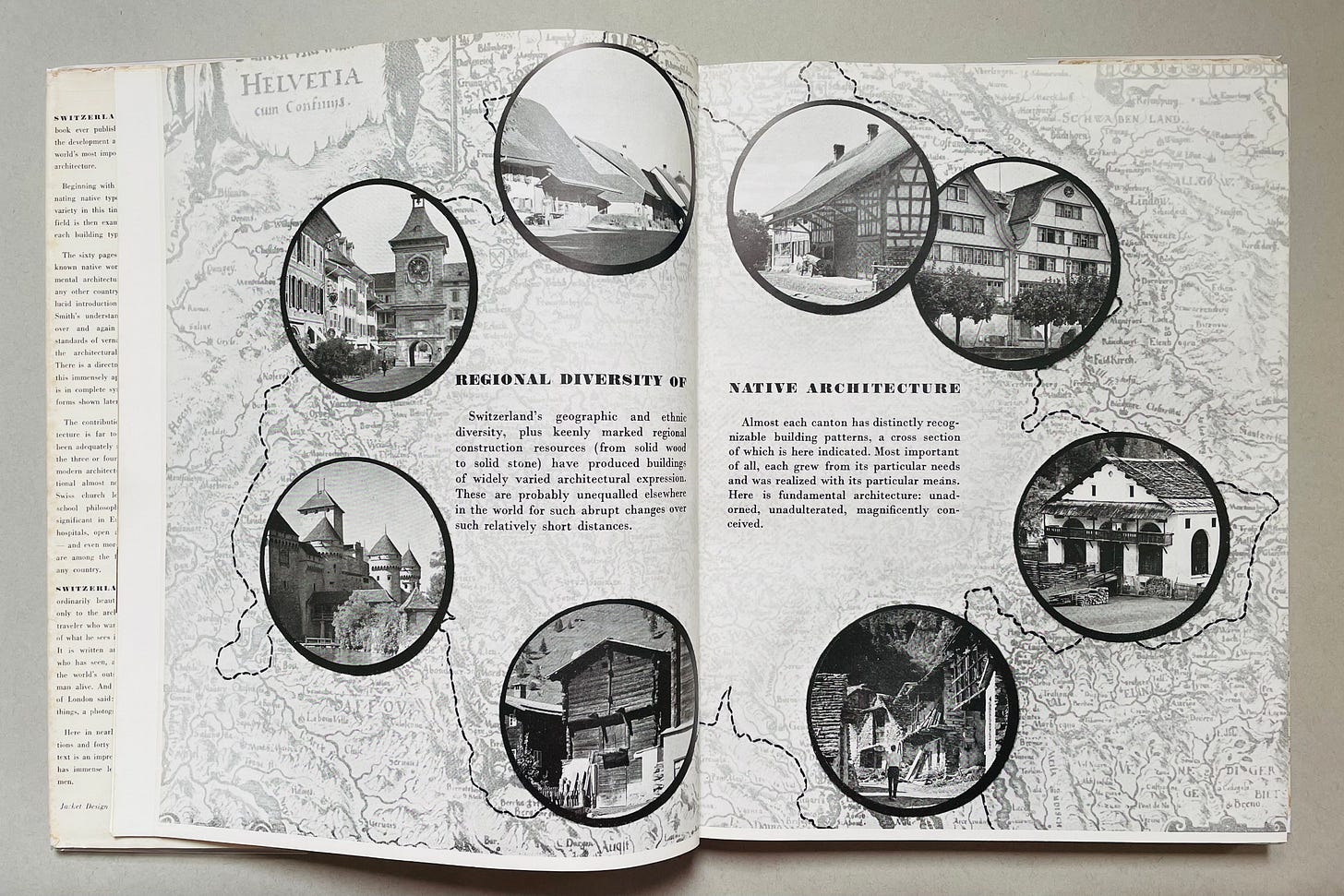
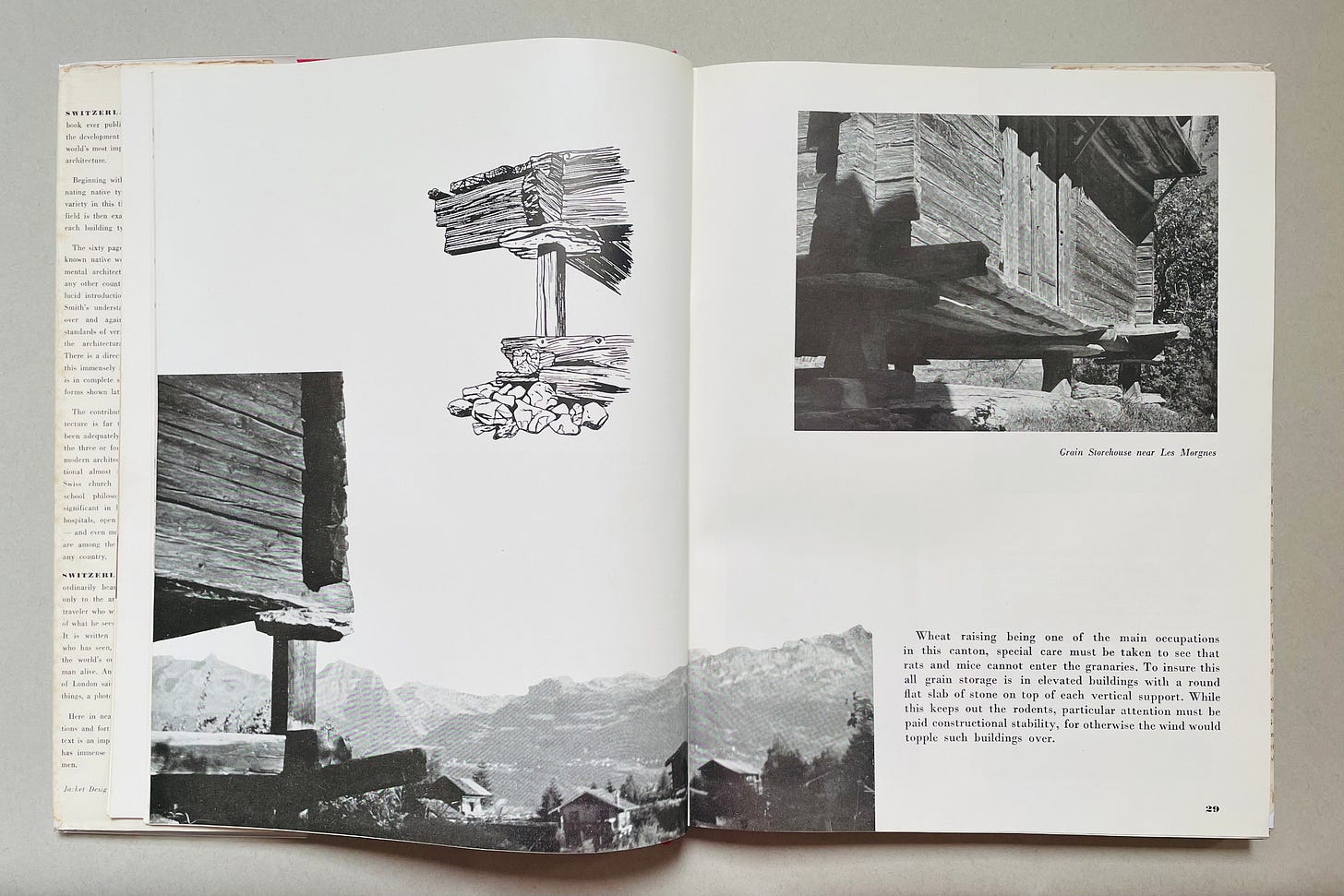
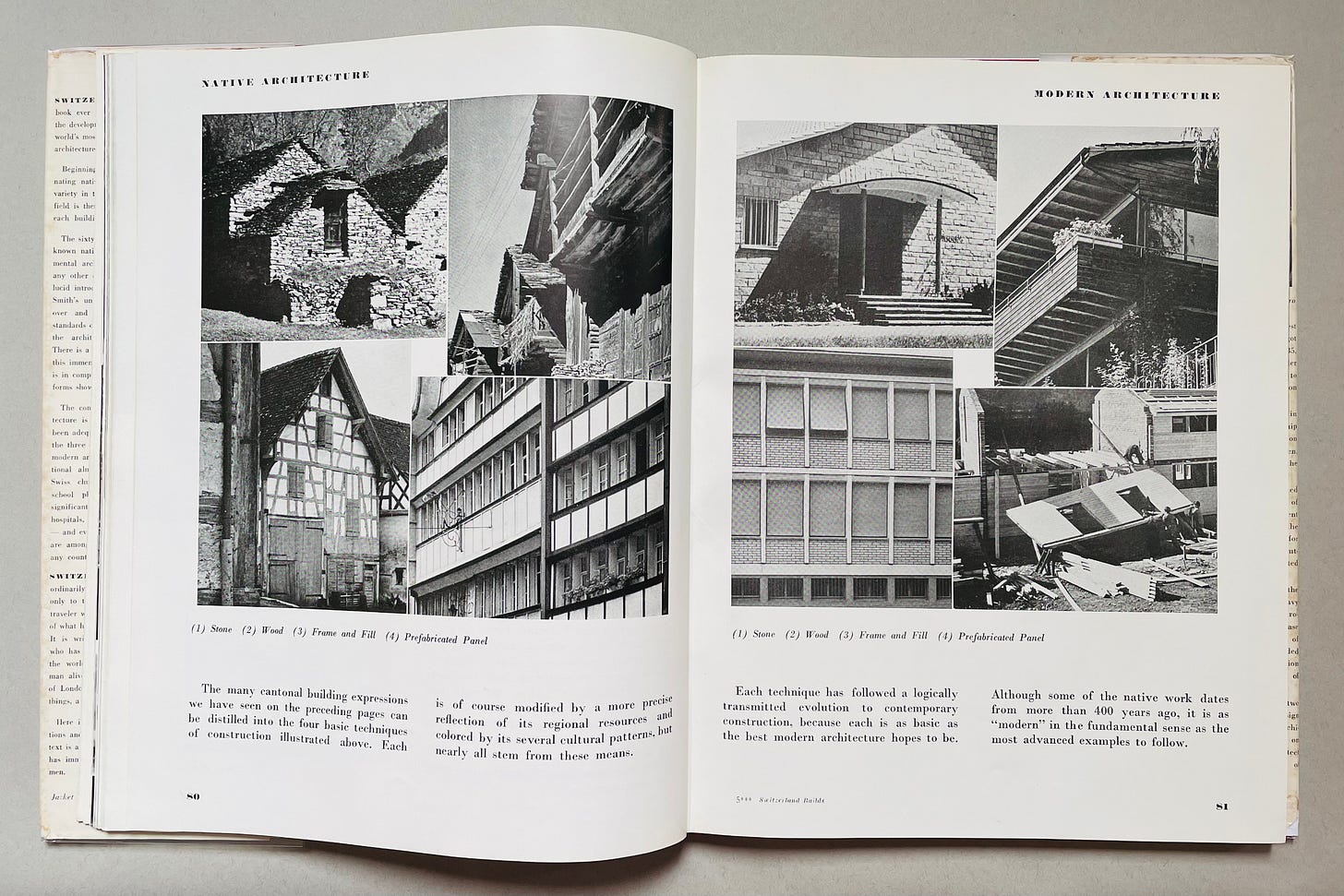
I remember driving past one of those towers in Glarus years ago, not knowing what it was, just thinking it looked like a quiet monument to some forgotten industry.
It’s fascinating how Baechler’s project turns these towers into something both personal and collective. The way she layers autobiography with archive, fabric with wood, is so Swiss in spirit,precise, tactile, and full of quiet memory.
I love that the book isn’t just about buildings but about care. Care for process, materials, timing. Even the part about building the rollers with her father hit me. So much of vernacular architecture lives and dies with the people who remember how to use it. Books like this help stretch that memory just a bit further.